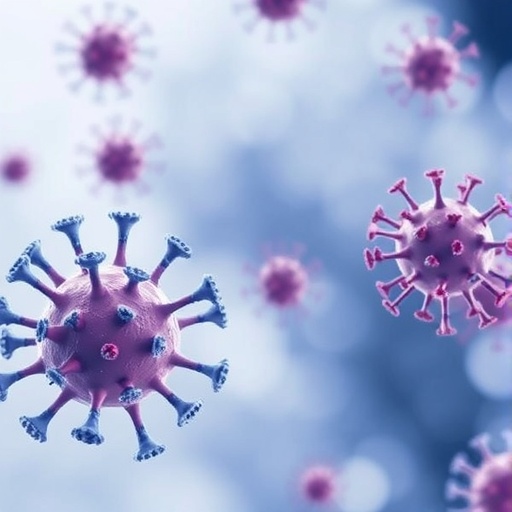In a groundbreaking study published in the Journal of General Internal Medicine, researchers, led by J. Li and his colleagues, shed light on a rare yet critical clinical phenomenon termed Adult Reactive Infectious Mucocutaneous Eruption (RIME). The study focuses on the occurrence of RIME in adult patients concurrently infected with adenovirus and Mycoplasma pneumoniae. This study is particularly significant because it could lead to a better understanding of how these dual infections manifest in the human body and their implications for internal medicine.
Mucocutaneous eruptions are clinical conditions characterized by inflammation and damage to mucosal surfaces and skin. These eruptions can arise due to various infectious agents, but the interplay of viral and bacterial pathogens can complicate the clinical picture. The authors provide a detailed account of three adult cases presenting with RIME symptoms connected to simultaneous adenoviral and Mycoplasma infection. The intricate pathways of immune response elicited by such infections can often overlap, making diagnosis and treatment challenging.
The adenovirus, a common viral pathogen, is known for causing respiratory illnesses, but its potential dermatological manifestations are often overlooked in adults. Researchers highlight that adenoviruses can trigger a response that leads to mucocutaneous lesions, particularly in individuals who might have compromised immune systems or other underlying health conditions. This raises pertinent questions about the implications of adenoviral infections that extend beyond the typical respiratory symptoms usually associated with the virus.
On the other hand, Mycoplasma pneumoniae is primarily recognized for causing atypical pneumonia, especially in younger populations. However, the bacterium has a spectrum of clinical manifestations, including extra-pulmonary complications. The authors discuss how Mycoplasma can provoke an immune response that may also lead to mucocutaneous symptoms, presenting a dual threat when occurring alongside adenoviral infections, thereby complicating the clinical outcomes and management of such cases.
The study meticulously evaluates the clinical presentations, laboratory findings, and treatment responses in the reported cases. Detailed descriptions of the eruptions observed, including their timing in relation to the onset of respiratory symptoms, are provided. The findings suggest that the mucocutaneous manifestations may serve as a vital clue in diagnosing concurrent infections between viral and bacterial pathogens. This is particularly useful in a clinical setting where the differentiation of causes is crucial for effective patient management.
In their approach, the researchers employed a comprehensive methodology that included detailed patient histories, clinical examinations, laboratory tests, and imaging studies where necessary. This holistic approach helped in establishing a correlation between the infections and the mucocutaneous eruptions. Furthermore, the authors utilized immune response assays to elucidate the pathophysiological mechanisms at work. These efforts demonstrate the importance of interdisciplinary cooperation in diagnosing and treating complex cases that involve intertwined infectious agents.
Therapeutic strategies for managing patients with RIME stemming from concurrent infections require a tailored approach. Conventional treatments for each pathogen might not suffice when both are present. The study emphasizes the importance of a combined treatment strategy, which may involve antiviral medications alongside antibiotics, a fine balance that needs careful monitoring and adjustment based on patient response. The role of supportive care cannot be overstated, as these patients often require hydration, pain management, and sometimes systemic corticosteroids to manage severe inflammatory responses.
The implications of this study extend beyond academic interest. As global travel increases, and pathogenic agents evolve, healthcare providers must remain vigilant about the potential for co-infections. The unique presentation of RIME as described in this study reinforces the necessity for awareness and education among healthcare professionals about non-traditional presentations of common pathogens. As noted in the research, clinicians must be prepared to recognize and manage such multifaceted cases effectively.
Moreover, the study touches on the broader public health implications of concurrent infections. With the rise of antibiotic resistance due to indiscriminate prescribing practices, understanding how these two pathogens interact becomes increasingly critical for guiding empirical treatment strategies in adult patients presenting with respiratory complaints. Efforts towards developing guidelines and protocols based on current research are vital for improving patient outcomes in these situations.
In conclusion, the study of Adult Reactive Infectious Mucocutaneous Eruption due to concurrent adenoviral and Mycoplasma pneumoniae infections is a thematic breakthrough that encourages further exploration into the interactions of viral and bacterial pathogens. This investigation opens avenues for future research that could examine the molecular basis of these interactions, promising potential advancements in diagnostic and therapeutic approaches in infectious diseases. Future studies funded and encouraged by various institutions will hopefully delve deeper into not only the clinical manifestations but also the long-term implications of having these co-infections.
Ultimately, the emergence and documentation of conditions like RIME challenge the medical community to broaden its perspective on infectious disease presentations. As research progresses, it underscores the very essence of internal medicine—holistic patient care that values the complexity of human health amid ever-evolving clinical challenges.
Subject of Research: Adult Reactive Infectious Mucocutaneous Eruption (RIME) from Concurrent Adenovirus and Mycoplasma pneumoniae Infections.
Article Title: Adult Reactive Infectious Mucocutaneous Eruption (RIME) from Concurrent Adenovirus and Mycoplasma pneumoniae Infections.
Article References:
Li, J., Noveir, S.D., Bouri, N. et al. Adult Reactive Infectious Mucocutaneous Eruption (RIME) from Concurrent Adenovirus and Mycoplasma pneumoniae Infections. J GEN INTERN MED (2025). https://doi.org/10.1007/s11606-025-09827-6
Image Credits: AI Generated
DOI: 10.1007/s11606-025-09827-6
Keywords: RIME, adenovirus, Mycoplasma pneumoniae, mucocutaneous eruption, concurrent infections, internal medicine.
Tags: adenovirus and Mycoplasma pneumoniaeadenovirus dermatological manifestationsAdult Reactive Infectious Mucocutaneous Eruptioncase studies on RIMEdiagnosis and treatment challengesdual infections in adultsimmune response to viral and bacterial pathogensimplications for internal medicineinfectious agents and mucosal surfaces.mucocutaneous eruptions in infectionsrespiratory illnesses and skin reactionsRIME clinical phenomenon





